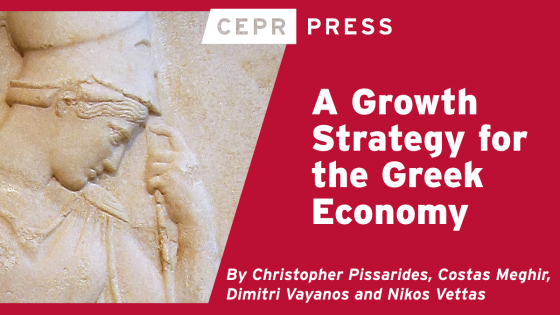The Argentina story has been used to describe problems in euro pegs and, more recently, in countries such as Greece and Spain. The underlying plot is ominously similar. In both cases, governments face a combination of a heavy debt burden that cannot be inflated away (because it is denominated in a foreign currency or in the common euro) and an important fiscal deficit testing the sustainability of servicing that debt. This in turn stirs market sentiment and widens sovereign spreads – possibly triggering a self-fulfilling run and a default.
Barring the unfeasible option of a one-off coordinated reduction of wages and prices across the board, an “internal devaluation” – an imperfect substitute for the unavailable exchange rate devaluation – can in principle happen through a slow reduction in nominal wages and salaries. This can be achieved through a combination of fiscal austerity and the prolonged and painful pressure of high unemployment.
The Argentina story is also resurrected in the discussion of internal devaluation variants. A (temporary) introduction of an alternative local currency could in principle facilitate the change in relative prices (see for example Goodhart and Tsomocos 2009). Alternatively, Feldstein (2010) proposes a temporary euro holiday, which might open the door for devaluations a la carte and might lethally jeopardise the euro – as argued on this site (Baldwin and Wyplosz 2010, Cavallo and Cottani 2010).
But here the analogy fails. The two varieties of internal devaluation were in fact sequentially explored back in 2001 (The Economist 2002), when Argentina faced the demise of the currency board. On 30 July, the government imposed a “zero deficit rule” that entailed automatic nominal cuts on public wages and pensions (13% in the first round). This flow adjustment, predictably, only accelerated the implosion of output and employment, which further undermined the government’s faltering political support (and fiscal balance) without making a significant dent towards the decline in nominal wages needed to sufficiently adjust the real exchange rate.
In turn, the introduction of an alternative currency did in fact appear through the emergence of quasi-monies. Provincial Treasuries started printing small-denomination bonds with funny names (patacones, porteños, quebrachos) to meet their obligations (typically wages, pensions, and suppliers), bypassing the limits imposed by the transfers from the central government. Ultimately, the national Treasury joined the club with the issuance of its own Lecops, in effect breaching the limits on monetary expansion imposed by the currency board.
But neither of the two avenues produced an internal (real) devaluation in Argentina. The polity could not stomach nominal wage cuts driven by fiscal austerity and employment contraction. And the quasi-monies did not trade at a discount compared with the Argentine peso. The former is easy to understand, given democracy. But why did the quasi-monies trade at a par? Why would anyone voluntarily accept an inferior currency without a discount? Where was the catch?
First, the quasi-monies were bills (IOUs that in some cases bore a token interest rate) issued at par to the convertible peso. Second, each government endeavoured to create demand for its own exotic species by accepting them at par for tax payment purposes. This explains why some large retail chains accepted these quasi-monies without penalty as means of exchange and why provincial quasi-monies fared much better in provinces with a solid tax base. Third, with the currency board still in place, the ongoing run against the peso induced a sharp monetary contraction compounded by the imposition of limits on cash withdrawals (the so-called “corralito” that dropped the gates on bank sight deposits). As shown in Levy Yeyati et al. (2004), this created an excess demand for any liquid means of exchange. Pesos were precious at the time, and the “quasis” did the trick rather well, in a re-enactment of Gresham´s Law.
These details of the Argentine story must be kept in mind when discussing internal devaluation options for peripheral Europe. An internal devaluation, if feasible, might help peripheral Europe in the adjustment process through a change in relative prices. But the comparisons with Argentina should be made with care. If anything, the Argentine experience undermines the case for the internal devaluation once key differences are considered.
The first difference is semantic. There is often confusion between the Argentine quasi-monies – which, being debt instruments, could only be repaid in full or restructured, but not devalued – and the idea to replace the quasi-monies by a new floating currency as an “orderly” way out of the currency board.1
Argentina’s quasi-monies were originally seen as a source of fiscal funding rather than as a devaluation shortcut. Their pegged nature propped their demand and maximised their value as a funding source, at the expense of rendering them useless as an internal devaluation vehicle. To the extent that the main role of the new currency in the European case would be to coordinate wages and prices cuts, it would require the full conversion of the domestic economy to the new currency, a de-euroisation experiment with no relevant precedence in modern history.
A second difference relates to the cost of such a regime switch. Abandoning the currency board was very costly for Argentina, even when the peso had been pegged through a unilateral decision that could be (and, eventually, was) unilaterally undone. The cost of abandoning the Latvian peg would certainly be higher because it would imply a significant delay in (if not the abandonment of) the euro adoption process. By the same token, abandoning the euro by introducing a new currency would be even more costly for a country like Greece.
The third difference is the flipside of the previous one. Argentina did not have solvent euro partners that might pitch in, even reluctantly, to preserve the status quo or avoid contagion. Moreover, Argentina did not present a serious contagion risk at that time – it was the last one left to devalue after other countries suffered currency collapses in the late 1990s. Finally, unlike European countries, Argentina had to rely on an IMF that, at the time, was championing the moral hazard view (through the “bailing in” doctrine) even at the risk of some casualties. In the absence of a bailout package, Argentina had practically no option but to implement the necessary Draconian adjustment.
This last point is critical in connection to any devaluation strategy (even a conventional one). A devaluation does not solve, and in fact often worsens, the debt sustainability problem. While a real devaluation could alleviate the lack of competitiveness in several European countries, enhancing their capacity to pay over the long run, its immediate effect would be to increase the debt-to-GDP ratios more or less proportionally. Without a source of short-term financing, this could trigger a run on the country’s assets and a debt default.
Better on paper
Times of crisis often stimulate the search for ingenuous lab solutions that look better on paper than in practice. The use of quasi-monies or the temporary introduction of a new floating currency are untested ideas that fit into this category. More importantly, none of them avoid the need for an important subsidy from the EU (in the form of lender of last resort assistance or credit guarantees) to help service the debt and phase in the required adjustment. Moreover such a subsidy would be motivated by the need to prop up the euro, a feeling that would be undermined by the introduction of a new currency. The only alternative to a costly internal devaluation under the euro system still is – as was the case in Argentina –a good old devaluation to break permanently free from the euro peg, an avenue that at this stage looks both politically unrealistic and economically suboptimal compared to a good old bailout, sufficient to prevent the exit from the euro but conditioned on getting the house in order.
Footnotes
1 A “pesification at the margin” that would have preserved the dollar value of existing financial contracts, thus helping contain the ongoing bank run (de la Torre et al., 2003, and Levy Yeyati et al 2010).
References
Baldwin, Richard and Charles Wyplosz (2010), “How to destroy the Eurozone: Feldstein’s euro-holiday idea”, VoxEU.org, 22 February.
Cavallo, Domingo and Joaquín Cottani (2010), “For Greece, a “fiscal devaluation” is a better solution than a “temporary holiday” from the eurozone”, VoxEU.org, 22 February.
de la Torre, Augusto, Eduardo Levy Yeyati, and Eduardo Schmukler (2003), “Living and Dying with Hard Pegs”, Economia, 43-107.
Feldstein, Martin (2010), “Let Greece Take a Holiday from the Eurozone”, Financial Times, 17 February.
Goodhart, Charles and Dimitrios Tsomocos (2010), “The Californian Solution for the Club Med”, Financial Times, 24 January.
Levy Yeyati, Eduardo, Maria Soledad Martinez Peria, and Sergio Schmukler (2010), “Market Discipline under Macroeconomic Risk,” Journal of Money, Credit, and Banking.
Levy Yeyati, Eduardo, Sergio Schmukler and Neeltje van Horen (2004), “The Price of Inconvertible Deposits”, Economic Letters, 83(1):7-13, April.
The Economist (2002) “Argentina’s Bottomless Pit,” Economics Focus, 8 August.





